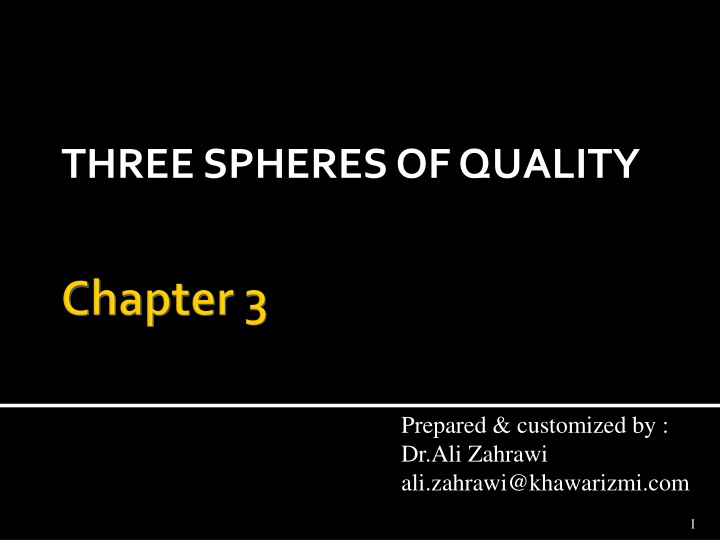
Evolution of Quality Management Spheres - Explained by Dr. Ali Zahrawi
Discover the evolution of quality management through the three spheres - quality control, quality assurance, and quality management. Learn how the role of quality professionals has shifted and the importance of total quality management. Explore the functions and overlaps of these spheres as presented in the late 1950s by pioneers like Armand Feigenbaum. Find out how quality control processes are based on scientific methods and the vital activities involved in maintaining quality standards. Dive into the changing landscape of quality departments and specialists in the new century of quality management.
Uploaded on | 10 Views
Download Presentation

Please find below an Image/Link to download the presentation.
The content on the website is provided AS IS for your information and personal use only. It may not be sold, licensed, or shared on other websites without obtaining consent from the author. If you encounter any issues during the download, it is possible that the publisher has removed the file from their server.
You are allowed to download the files provided on this website for personal or commercial use, subject to the condition that they are used lawfully. All files are the property of their respective owners.
The content on the website is provided AS IS for your information and personal use only. It may not be sold, licensed, or shared on other websites without obtaining consent from the author.
E N D
Presentation Transcript
THREE SPHERES OF QUALITY Prepared & customized by : Dr.Ali Zahrawi ali.zahrawi@khawarizmi.com 1
Wall Street Journal reveal job openings for quality managers and engineers. The role of these departments and specialists are changing in the new century of quality. Historically, the quality management department performed a policing function in the firm. Quality managers will responsible for quality conformance and spent their time ferret out causes of defects. 2 Chapter 3 -- Three spheres of Quality
In the late 1950s, Armand Feigenbaum and others showed the limitations of this approach. The movement began toward the total involvement of employees spawning total quality management (TQM). With total involvement, the role of the quality department moved from a technical, inspection role to a supportive training and coaching role. Chapter 3 -- Three spheres of Quality3
As a manager or a quality specialist, you will be ask to either arrange or perform quality-related training. The ability to conduct effective training and to facilitate teams are important tools for the quality professional. Is quality management its own functional discipline? Yes and no. Consultants, quality engineers, trainers, coaches, and managers are still needed. A strong knowledge of quality is best coupled with technical experts in other areas such as materials management, finance, accounting, operations management, human resources management, strategy, industrial engineering, or myriad other disciplines. Chapter 3 -- Three spheres of Quality4
One way to conceptualize the field of quality management is known as three spheres of quality. These spheres are quality control, quality assurance, and quality management, and their functions overlap as seen in Figure Chapter 3 -- Three spheres of Quality5
Quality Management Quality Quality Control Assurance Figure: 3-Sphere of quality 6 Chapter 3 -- Three spheres of Quality
Quality Control The control process is based on the scientific methods. Includes phases of analysis, relation, and generalization. Activities relating to quality control include: Monitoring process capability and stability Measuring process performance Reducing process variability Optimizing processes to nominal measures Performing acceptance sampling Developing and maintaining control charts 7
Quality Assurance Refers to activities associated with guaranteeing the quality of a product or service. These activities are design-related. Quality control is reactive rather than proactive by detecting quality problems after they occur. The best way to assure quality is in the design of product, service, and processes. Chapter 3 -- Three spheres of Quality 8
Quality Assurance - Quality assurance activities include tasks such as: Failure mode and effects analysis Concurrent engineering Experimental Design Process improvements Design team formation and management Off-line experimentation Reliability/durability product testing 9
Quality Management The management processes that overarch and tie together the control and assurance activities make up quality management. Quality Highlight is an example of a company with effective quality management. Quality is the responsibility of all management, not just quality managers. For this reason, a variety of managers, supervisors, and employees are involved in quality management activities such as next slide. 10
Activities of Quality Management Planning for quality improvement Creating a quality organizational culture Providing leadership and support Providing training and retraining Designing an organizational system that reinforces quality ideals Providing employee recognition Facilitating organizational communication Chapter 3 -- Three spheres of Quality 11
1. The Value-Added Perspective on Quality 2. Cultural Perspectives on Quality International marketers have long noted A customer-based perspective on that there are differences in tastes and quality that is utilized by services, preferences between cultures and manufacturing, and public sector nations. organizations involves the concept of value. As a result, approaches to quality Involves a subjective assessment of the improvement may differ across culture. efficacy of every step of the process for It is not so obvious that approaches to the customer. quality improvement may differ A value-added activity can be according to culture. pinpointed by asking, would this Cultures that are more class-conscious activity matter to the customer? or command-and-control oriented - A value-added activity will have might have trouble delegating decision economic value to the customer. making to lower levels of employees. Chapter 3 -- Three spheres of Quality 12













